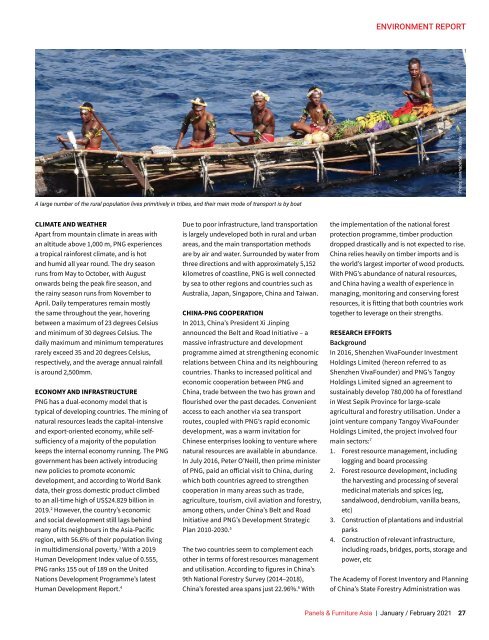Panels & Furniture Asia January/February 2021
Panels & Furniture Asia (PFA) is a leading regional trade magazine dedicated to the woodbased panel, furniture and flooring processing industry. Published bi-monthly since 2000, PFA delivers authentic journalism to cover the latest news, technology, machinery, projects, products and trade events throughout the sector. With a hardcopy and digital readership comprising manufacturers, designers and specifiers, among others, PFA is the platform of choice for connecting brands across the global woodworking landscape.
Panels & Furniture Asia (PFA) is a leading regional trade magazine dedicated to the woodbased panel, furniture and flooring processing industry. Published bi-monthly since 2000, PFA delivers authentic journalism to cover the latest news, technology, machinery, projects, products and trade events throughout the sector. With a hardcopy and digital readership comprising manufacturers, designers and specifiers, among others, PFA is the platform of choice for connecting brands across the global woodworking landscape.
You also want an ePaper? Increase the reach of your titles
YUMPU automatically turns print PDFs into web optimized ePapers that Google loves.
ENVIRONMENT REPORT<br />
Photo: ianknabel66 / Pixabay<br />
A large number of the rural population lives primitively in tribes, and their main mode of transport is by boat<br />
CLIMATE AND WEATHER<br />
Apart from mountain climate in areas with<br />
an altitude above 1,000 m, PNG experiences<br />
a tropical rainforest climate, and is hot<br />
and humid all year round. The dry season<br />
runs from May to October, with August<br />
onwards being the peak fire season, and<br />
the rainy season runs from November to<br />
April. Daily temperatures remain mostly<br />
the same throughout the year, hovering<br />
between a maximum of 23 degrees Celsius<br />
and minimum of 30 degrees Celsius. The<br />
daily maximum and minimum temperatures<br />
rarely exceed 35 and 20 degrees Celsius,<br />
respectively, and the average annual rainfall<br />
is around 2,500mm.<br />
ECONOMY AND INFRASTRUCTURE<br />
PNG has a dual-economy model that is<br />
typical of developing countries. The mining of<br />
natural resources leads the capital-intensive<br />
and export-oriented economy, while selfsufficiency<br />
of a majority of the population<br />
keeps the internal economy running. The PNG<br />
government has been actively introducing<br />
new policies to promote economic<br />
development, and according to World Bank<br />
data, their gross domestic product climbed<br />
to an all-time high of US$24.829 billion in<br />
2019. 2 However, the country’s economic<br />
and social development still lags behind<br />
many of its neighbours in the <strong>Asia</strong>-Pacific<br />
region, with 56.6% of their population living<br />
in multidimensional poverty. 3 With a 2019<br />
Human Development Index value of 0.555,<br />
PNG ranks 155 out of 189 on the United<br />
Nations Development Programme’s latest<br />
Human Development Report. 4<br />
Due to poor infrastructure, land transportation<br />
is largely undeveloped both in rural and urban<br />
areas, and the main transportation methods<br />
are by air and water. Surrounded by water from<br />
three directions and with approximately 5,152<br />
kilometres of coastline, PNG is well connected<br />
by sea to other regions and countries such as<br />
Australia, Japan, Singapore, China and Taiwan.<br />
CHINA-PNG COOPERATION<br />
In 2013, China’s President Xi Jinping<br />
announced the Belt and Road Initiative – a<br />
massive infrastructure and development<br />
programme aimed at strengthening economic<br />
relations between China and its neighbouring<br />
countries. Thanks to increased political and<br />
economic cooperation between PNG and<br />
China, trade between the two has grown and<br />
flourished over the past decades. Convenient<br />
access to each another via sea transport<br />
routes, coupled with PNG’s rapid economic<br />
development, was a warm invitation for<br />
Chinese enterprises looking to venture where<br />
natural resources are available in abundance.<br />
In July 2016, Peter O’Neill, then prime minister<br />
of PNG, paid an official visit to China, during<br />
which both countries agreed to strengthen<br />
cooperation in many areas such as trade,<br />
agriculture, tourism, civil aviation and forestry,<br />
among others, under China’s Belt and Road<br />
Initiative and PNG’s Development Strategic<br />
Plan 2010-2030. 5<br />
The two countries seem to complement each<br />
other in terms of forest resources management<br />
and utilisation. According to figures in China’s<br />
9th National Forestry Survey (2014–2018),<br />
China’s forested area spans just 22.96%. 6 With<br />
the implementation of the national forest<br />
protection programme, timber production<br />
dropped drastically and is not expected to rise.<br />
China relies heavily on timber imports and is<br />
the world’s largest importer of wood products.<br />
With PNG’s abundance of natural resources,<br />
and China having a wealth of experience in<br />
managing, monitoring and conserving forest<br />
resources, it is fitting that both countries work<br />
together to leverage on their strengths.<br />
RESEARCH EFFORTS<br />
Background<br />
In 2016, Shenzhen VivaFounder Investment<br />
Holdings Limited (hereon referred to as<br />
Shenzhen VivaFounder) and PNG’s Tangoy<br />
Holdings Limited signed an agreement to<br />
sustainably develop 780,000 ha of forestland<br />
in West Sepik Province for large-scale<br />
agricultural and forestry utilisation. Under a<br />
joint venture company Tangoy VivaFounder<br />
Holdings Limited, the project involved four<br />
main sectors: 7<br />
1. Forest resource management, including<br />
logging and board processing<br />
2. Forest resource development, including<br />
the harvesting and processing of several<br />
medicinal materials and spices (eg,<br />
sandalwood, dendrobium, vanilla beans,<br />
etc)<br />
3. Construction of plantations and industrial<br />
parks<br />
4. Construction of relevant infrastructure,<br />
including roads, bridges, ports, storage and<br />
power, etc<br />
The Academy of Forest Inventory and Planning<br />
of China’s State Forestry Administration was<br />
<strong>Panels</strong> & <strong>Furniture</strong> <strong>Asia</strong> | <strong>January</strong> / <strong>February</strong> <strong>2021</strong> 27


















